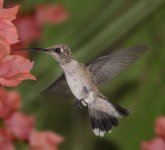There are four hummer species here this summer, about 12 -15 total.
Two of these are male black-chinned (have seen no females) ... and the rest are [male, female, and juvenile] Anna's, Costa's, and broad-billed, in about equal numbers.
I only saw this bird once. (Photo below.) And I only had time to take this one picture. It was here for a few seconds -- and then gone.
At the time I saw it (just a quick glance) I thought it was a juvenile broad-billed. My impression was that it was larger than the Anna's, Costa's and black-chinned hummers and moved and acted like the broadbills do.
After seeing the picture though, I don't know what it is. Somehow it doesn't look like a juvenile at all -- more like an adult female. But which species? It's not an adult female broad-billed. Maybe a f. black-chinned?
I think it's probably a hummer that was just passing through and stopped to eat, since I haven't seen it again. But I'd really like to know what it is.
Help, anyone? Thanks!
Two of these are male black-chinned (have seen no females) ... and the rest are [male, female, and juvenile] Anna's, Costa's, and broad-billed, in about equal numbers.
I only saw this bird once. (Photo below.) And I only had time to take this one picture. It was here for a few seconds -- and then gone.
At the time I saw it (just a quick glance) I thought it was a juvenile broad-billed. My impression was that it was larger than the Anna's, Costa's and black-chinned hummers and moved and acted like the broadbills do.
After seeing the picture though, I don't know what it is. Somehow it doesn't look like a juvenile at all -- more like an adult female. But which species? It's not an adult female broad-billed. Maybe a f. black-chinned?
I think it's probably a hummer that was just passing through and stopped to eat, since I haven't seen it again. But I'd really like to know what it is.
Help, anyone? Thanks!





